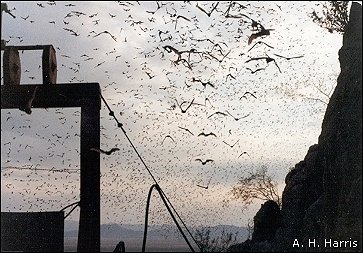

Being in the right place at the right time has always been the dream of the ambitious. Many a entrepreneur has risen from obscurity because of just that happy coincident. But humans aren't the only creatures who gain by such. Many a group of animals or plants has managed to grasp the opportunity offered and achieved success beyond belief. Indeed, recent studies suggest that our second most common group of mammals, the bats, not only received evolutionary impetus from the place and time happenstance, but seized the opportunity so whole-heartedly that they quickly dominated the night skies of the Eocene epoch.
The early Eocene, around 50 to 55 million years ago, saw spikes in mean
temperatures, and in plant and insect diversity. With the twin innovations of flight
and echolocation already in hand, the bats were in perfect position to take full
advantage of plentiful night-flying prey. By the end of the Eocene, some 35 million
years ago, all 18 living families of bat were soaring through the darkness, even as
they do today in our Chihuahuan Desert.

Contributor: Arthur H. Harris, Laboratory for Environmental Biology, Centennial Museum, University of Texas at El Paso.
Desert Diary is a joint production of the Centennial Museum and KTEP National Public Radio at the University of Texas at El Paso.

Brazilian Free-tailed Bats (Tadarida brasiliensis) leaving a roost in extreme southwestern New Mexico. Photograph by A.H. Harris.
